|
|
|
Sort Order |
|
|
|
Items / Page
|
|
|
|
|
|
|
| Srl | Item |
| 1 |
ID:
168550
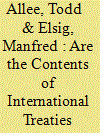

|
|
|
|
|
| Summary/Abstract |
Most accounts of international negotiations suggest that global agreements are individually crafted and distinct, while some emerging scholarship suggests a heavy reliance on models and templates. In this research, we present a comprehensive test of whether new international treaties are heavily copied and pasted from past ones. We specify several reasons to expect widespread copying and pasting, and argue that both the most and least powerful countries should be most likely to do so. Using text analysis to examine several hundred preferential trade agreements (PTAs), we reveal that most PTAs copy a sizable majority of their content word for word from an earlier agreement. At least one hundred PTAs take 80 percent or more of their contents directly from a single, existing treaty—with many copying and pasting 95 percent or more. These numbers climb even higher when we compare important substantive chapters of trade agreements, many of which are copied and pasted verbatim. Such copying and pasting is most prevalent among low-capacity governments that lean heavily on existing templates, and powerful states that desire to spread their preferred rules globally. This widespread replication of existing treaty language reshapes how we think about international cooperation, and it has important implications for literatures on institutional design, policy diffusion, state power, and legal fragmentation.
|
|
|
|
|
|
|
|
|
|
|
|
|
|
|
|
| 2 |
ID:
140720


|
|
|
|
|
| Summary/Abstract |
Economists have warned for many years that preferential trade agreements (PTAs) will not necessarily increase economic welfare in Australia given the relatively small size of the economy and the country’s lack of negotiating coin. The Productivity Commission cautioned in its major report on PTAs that there seemed to be a mindset of ‘agreements for agreement’s sake’, in part because of fears of missing out on a bandwagon that has attracted Australia’s major trading partners. Political and security considerations have played an important role in shaping Australia’s approach to PTAs. When politics trumps economics in negotiations of PTAs there is a risk of a rush to premature agreement that produces sub-optimal outcomes, that undermines broader plurilateral and global negotiations, and that introduces new and undesirable distortions in trade and public policies. Various theoretical approaches to trade policymaking provide insights into why Australian governments have been willing to conclude these sub-optimal deals.
|
|
|
|
|
|
|
|
|
|
|
|
|
|
|
|
| 3 |
ID:
159248
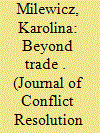

|
|
|
|
|
| Summary/Abstract |
Increased complexity and density of transnational problems create unprecedented challenges and opportunities for contemporary international governance. “Issue linkage” is one institutional arrangement through which states address these changing circumstances. In this article, we examine the widening scope of the nontrade agenda in preferential trade agreements (PTAs). Nontrade issues (NTIs) such as human rights, democracy, environment, corruption, and labor standards are increasingly linked to PTAs. This issue linkage has important implications for understanding changing patterns of international trade, including the shift to PTAs and the rise of NTIs. We show that (1) states’ choices to commit to bilateral or plurilateral versions of traditional PTAs and to PTAs with NTIs are highly interdependent, (2) states increasingly incorporate NTIs into PTAs, as the associated costs of policy change are lowered through earlier agreements, and (3) network pressures favor the increasing adoption of bilateral and especially plurilateral NTIs over time. Using an original data set on NTIs covering 522 PTAs and spanning the period 1951 to 2009, we evaluate states’ motives behind the widening nontrade agenda of trade agreements using longitudinal network modeling. We employ multiplex coevolution stochastic actor-oriented network models in a novel design to account for interdependencies within and across states’ decisions. Following a descriptive mapping of major NTIs, we evaluate our theoretical arguments. Testing against the alternative explanations of power and commitment, we find that endogenous cost considerations are the most significant factor explaining the inclusion of NTIs into PTAs.
|
|
|
|
|
|
|
|
|
|
|
|
|
|
|
|
| 4 |
ID:
094086


|
|
|
|
|
| Publication |
2010.
|
| Summary/Abstract |
The landscape of the global economy is dotted with institutions that regulate investment and trade. in recent years, the number of bilateral investment treaties (BITs) and preferential trade agreements (PTAs), in particular, has grown at a torrid pace; practically every country is a member of at least one-if not many-of these institutions. For all the scholarly attention that these institutions have received, however, there is little research tying BITs and PTAs together. this is surprising, since both aim to increase commerce by making it more predictable. The authors seek to fill this gap in the literature. They argue that a BIT between a developed and a developing country should make it more likely that this pair of states will subsequently form a PTA. that said, the wrinkle in the story is that more is not better in this regard; the authors further argue that a developing country that has many BITs is less likely to conclude a PTA with a wealthy state. The authors test these hypotheses using annual data on pairs of developing and developed countries between 1960 and 2004 and find strong evidence in support of their argument.
|
|
|
|
|
|
|
|
|
|
|
|
|
|
|
|
| 5 |
ID:
120720
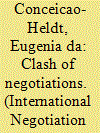

|
|
|
|
|
| Publication |
2013.
|
| Summary/Abstract |
Abstract While the number of preferential trade agreements (PTA) has increased rapidly in recent years, the Doha round of multilateral trade negotiations has been deadlocked since 2006. Most PTAs were even concluded after the start of the Doha round. Does the shift to PTAs "marginalize" the multilateral system? And is there a clash between preferential and multilateral trade liberalization? To answer these questions, we build upon negotiation analysis literature, arguing that the proliferation of PTAs draws negotiating capacity away from the multilateral level and thus reduces the incentives to agree on multilateral trade agreements. The willingness of actors to move from their initial bargaining positions and make concessions at the multilateral level depends on their outside options, that is, their best or worst alternatives to a negotiated agreement. The more credible an actor's argument that he has a good alternative to multilateralism, the greater his bargaining power will be. In order to support the argument we will analyze the negotiation process at the multilateral level and link it to PTAs under negotiation by the EU, US, Brazil, Australia, and India.
|
|
|
|
|
|
|
|
|
|
|
|
|
|
|
|
| 6 |
ID:
115729
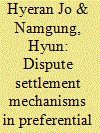

|
|
|
|
|
| Publication |
2012.
|
| Summary/Abstract |
Preferential trade agreements (PTAs) have increased dramatically in the past several decades and play an important role in the global economy. Dispute settlement mechanisms (DSMs) in these international agreements significantly influence their functioning. In this article, the authors seek to understand what factors determine the legal arrangements of these mechanisms. The authors argue that the confluence of domestic political regime type, emulation incentives, and the development of the multilateral trade regime determines their legal dimension. Using a data set of PTAs between 1957 and 2008, the authors show that (1) democracies are more likely than autocracies to prefer moderately strict DSMs, (2) trading partners increasingly emulate each other by adopting similar legal templates, and (3) the recent trend against legalistic mechanisms is largely driven by the development of the multilateral trade regime. Their findings have important implications for the design of international institutions by highlighting the importance of member-specific as well as macro-level factors.
|
|
|
|
|
|
|
|
|
|
|
|
|
|
|
|
| 7 |
ID:
082365


|
|
|
|
|
| Publication |
2008.
|
| Summary/Abstract |
This paper gives a short history of the development of preferential trade agreements (PTAs), followed by a summary of the economics of PTAs. The paper then examines the typical coverage of recent PTAs, and assesses their likely economic effects. Political economy considerations mean that PTAs have tended to be selective in two important ways-they have tended to be preferential, even in the provisions that go beyond goods trade, and they have tended to target only those provisions that explicitly discriminate against foreigners. This selectivity means that PTAs are an inferior path to deeper economic integration. For most of the Asian region, comprehensive domestic regulatory reform dominates as an integration strategy, while PTAs deliver relatively trivial gains. Multilateral action is an intermediate strategy, and is important for delivering trade liberalisation in sensitive sectors or in highly protected economies. These results appear to be relatively robust to the size of the PTA grouping.
|
|
|
|
|
|
|
|
|
|
|
|
|
|
|
|
| 8 |
ID:
155096


|
|
|
|
|
| Summary/Abstract |
Of the recent transformations in the political economy of the Asia-Pacific, one of the most dramatic has been to the region's trade architecture. For many years, Asian government were committed trade multilateralists: pursuing liberalisation either globally through the GATT, or regionally via APEC's model of open regionalism. Underpinned by US and Japanese leadership, this system provided the foundation for the export-driven Asian economic miracle. But since the early twenty-first century, the system has been rapidly transformed. The proliferation of preferential trade agreements has threatened to undermine the cohesiveness of regional trade arrangements. The emergence of WTO-Plus style liberalisation, emphasising services, investment and intellectual property, marks the maturation of a system previously focussed on tariff reduction and manufacturing exports. Since 2011, competition between two ‘mega-regional’ proposals – the Trans-Pacific Partnership and the Regional Comprehensive Economic Partnership – is also indicative of new splits which cut across traditional developmental divides. Growing geopolitical rivalry between the US and China has also raised question of who will lead the next round of liberalisation in the region. Exploring these new trends, this paper argues the trade architecture of the Asia-Pacific is entering is becoming more contested and fragmented, with major implications for economic regionalism in coming years.
|
|
|
|
|
|
|
|
|
|
|
|
|
|
|
|
| 9 |
ID:
139407
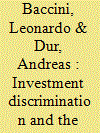

|
|
|
|
|
| Summary/Abstract |
The proliferation of bilateral and regional trade agreements has arguably been the main change to the international trading system since the end of the Uruguay Round in the mid-1990s. We argue that investment discrimination plays a major role in this development. Preferential trade agreements can lead to investment discrimination because of tariff differentials on intermediary products and as a result of provisions that relax investment rules for the parties to the agreement. Excluded countries are sensitive to the costs that this investment discrimination imposes on domestic firms and react by signing a trade agreement that aims at leveling the playing field. We test our argument using a spatial econometric model and a newly compiled data set that includes 166 countries and covers a period of eighteen years (1990–2007). Our findings strongly support the argument that investment discrimination is a major driver of the proliferation of trade agreements.
|
|
|
|
|
|
|
|
|
|
|
|
|
|
|
|
| 10 |
ID:
082364
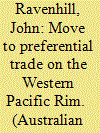

|
|
|
|
|
| Publication |
2008.
|
| Summary/Abstract |
Since* the turn of the century the Asia-Pacific region has become the most active location for the negotiation of preferential trade agreements (PTAs)-a dramatic change from the period before the financial crises of 1997-98. Substantial variance in scope exists among the more than 80 PTAs currently being implemented, negotiated or which are under study in the region. Those involving the United States are by far the most comprehensive. At the other end of the spectrum are those involving ASEAN and China, which are largely 'aspirational' in their provisions. This variance points to the range of economic and political objectives that PTAs serve. Regardless of the comprehensiveness of their coverage, the overall economic effects of the new PTAs is likely to be small given the prevailing low level of tariffs, the intervention of other factors such as fluctuating exchange rates, the proliferation of agreements (which removes the advantages they accord individual partners), and the unwillingness of governments to liberalise 'sensitive' sectors. Few of the agreements move substantially beyond existing WTO provisions. The proliferation of PTAs not only has tended to shift attention and resources away from negotiations at the global level but also runs the risk of fragmenting the 'pro-liberalisation' coalition in countries that have signed multiple agreements.
|
|
|
|
|
|
|
|
|
|
|
|
|
|
|
|
| 11 |
ID:
090428
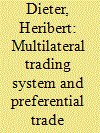

|
|
|
|
|
| Publication |
2009.
|
| Summary/Abstract |
Preferential trade agreements pose a big challenge for the multilateral trading system. Throughout the first decade of the twenty-first century, their number has grown significantly. However, these agreements have a range of disadvantages compared with the multilateral regime, for example, in trade facilitation and in dispute settlement. Whereas it will be difficult to stop the further spreading of this wave of preferential agreements, attempts can be made to reduce the negative effects of trade agreements that do, by definition, discriminate against other countries. In this article, a range of potential remedies are discussed, from a moratorium to the better enforcement of World Trade Organization rules on preferential agreements as well as improved monitoring.
|
|
|
|
|
|
|
|
|
|
|
|
|
|
|
|
| 12 |
ID:
165867
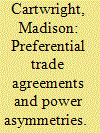

|
|
|
|
|
| Summary/Abstract |
Since the 1980s states have sought to harmonise economic standards to aid the flow of goods, services and finance across borders. The founding agreements of the World Trade Organisation (WTO), for example, harmonised standards on services, intellectual property and investment. However, mutlilateral trade negotiations in the WTO have since stalled. In response, the United States (US) has engaged in forum shopping, using preferential trade agreements at the bilateral, regional and multinational level to harmonise international standards. This article argues that through forum shopping the US has been able to export standards that support the commercial interests of US-based industries more than they encourage economic exchange across borders. Furthermore, because power asymmetries are starker in preferential trade negotiations smaller and middle power states should not enter trade agreements, which include regulatory harmonisation. This is illustrated with the case of the US-Australia free trade agreement, looking specifically at a copyright standard known as technological protection measures (TPMs). It was clear before, during and after the agreement was signed that Australia’s existing standard on TPMs was more popular than the US-style standard. Nevertheless, a US-style standard is in effect domestically because of the trade agreement.
|
|
|
|
|
|
|
|
|
|
|
|
|
|
|
|
| 13 |
ID:
080625
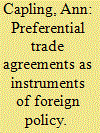

|
|
|
|
|
| Publication |
2008.
|
| Summary/Abstract |
The proliferation of preferential trade agreements (PTAs) in the Asia Pacific region is widely seen as a pragmatic response by governments to the bogging down of the regional and multilateral trade institutions. Analysis of these PTAs has focused primarily on their trade and economic dimensions. There has been less discussion and analysis of the geo-political and strategic dimensions of PTAs in the region. This article explores these issues with reference to the negotiation of a bilateral trade agreement between Australia and Japan. It argues that the drivers for this negotiation are primarily geo-political and strategic rather than economic and commercial, and it explores the potential implications of this. It concludes that the subordination of trade and economic concerns to broader foreign policy objectives in the pursuit of PTAs carries with it considerable risks, not just for Australia and Japan but also for the Asia Pacific region more generally
|
|
|
|
|
|
|
|
|
|
|
|
|
|
|
|
| 14 |
ID:
141841


|
|
|
|
|
| Summary/Abstract |
For several years now, China has implemented policies to promote the international use of its national currency, the Renminbi (RMB). As part of these efforts, the People's Bank of China (PBC) has negotiated 25 bilateral currency swap agreements (BSAs) with foreign central banks. These make it easier for firms in both China and its partner countries to settle cross-border trade and direct investment in RMB. We seek to explain why China and these countries cooperate via BSAs. We theorize that trade and direct investment interdependence relate to dyadic BSA cooperation via two mechanisms: financing insulation from international liquidity shocks and reduced transaction costs of cross-border exchange for local firms. Additionally, we expect the presence of preferential trade agreements (PTAs) and bilateral investment treaties (BITs) will increase the probability of dyadic BSA cooperation. BSAs are natural extensions of these existing agreements. They represent an additional layer of state-level formal cooperation that further reduces barriers to cross-border trade and direct investment. Our empirical analysis finds that both de facto trade interdependence and de jure economic integration via PTAs and BITs increase the probability of BSA cooperation between China and partners.
|
|
|
|
|
|
|
|
|
|
|
|
|
|
|
|
| 15 |
ID:
114815
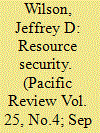

|
|
|
|
|
| Publication |
2012.
|
| Summary/Abstract |
Following a historical commitment to multilateralism, in the last decade the trade policy initiatives of many states in the Asia-Pacific have turned to bilateralism through the negotiation of free trade agreements (FTAs). The corresponding proliferation of regional FTAs has thus far been understood to result from three broad motivations: a desire to advance trade liberalization beyond World Trade Organization (WTO) disciplines; mercantilistic efforts to secure preferential access to key export markets; and/or attempts to use FTAs to secure non-economic political gains. This paper argues that since the middle of the decade a new motive has emerged - the use of FTAs to improve resource security - particularly by import-dependent resource consumers in Northeast Asia. As yet unexamined in the literature, this paper seeks to document and explain this trend. It analyses the recent emergence of resource security concerns as a new FTA motive; the corresponding shifts in the FTA strategies and initiatives of Japan, Korea and China; and the dynamics of an emerging race for resource-related FTAs between the three governments. Based on this analysis, it demonstrates that resource-related FTAs could potentially improve consumers' resource security through either the liberalization of trade, the extension of investment protections or broader diplomatic gains with the targeted supplier. However, owing to supplier reluctance to enter into binding policy commitments for resource industries, their track record shows success in only the diplomatic dimension, and the prospects for a strengthening of their effects are poor. As a result, it is argued that while resource concerns have become a key motive for FTA initiatives in the Asia-Pacific region, they have not substantively improved resource security for its import-dependent states and are unlikely to do so in the future.
|
|
|
|
|
|
|
|
|
|
|
|
|
|
|
|
| 16 |
ID:
151279


|
|
|
|
|
| Summary/Abstract |
Preferential trade agreements (PTAs) constitute the most rapidly growing form of trade liberalization in the global economy. In contrast to, for example, the World Trade Organization, PTAs allow for discrimination among potential partner countries. This helps explain their proliferation. But it also raises an important question: which countries are preferred partners for PTAs? On the presumption that public opinion matters—both normatively and analytically—for trade policy, we study what types of countries citizens prefer for PTAs. We focus on developing countries, as they both play an increasingly important role in the expanding global network of PTAs and also remain understudied in the literature on international cooperation and trade policy. To account for the multidimensionality of PTA partner country choice, we develop and test a theoretical framework through conjoint experiments embedded in national surveys in Costa Rica, Nicaragua, and Vietnam. The results show that, despite starkly divergent national contexts, citizens in all three countries opt for similar partner countries. Respondents prefer culturally similar countries, democracies, and countries that maintain high environmental and labor standards. Somewhat surprisingly, economic size and geographic distance prove less important in the choice of which countries to support as PTA partners.
|
|
|
|
|
|
|
|
|
|
|
|
|
|
|
|
| 17 |
ID:
082369


|
|
|
|
|
| Publication |
2008.
|
| Summary/Abstract |
Most analysts agree that the recent proliferation of Preferential Trade Agreements (PTAs) is largely the result of exasperation with multilateral trade liberalisation through the World Trade Organisation and a defensive response to the large-scale adoption of PTAs by major economies. The spread of PTAs, however, suggests that there are motivations other than economic that are inspiring these trade deals. It is becoming increasingly obvious that the use of PTAs to gain or reinforce strategic benefits, or to forestall strategic disadvantage, has been a major but largely unacknowledged driver of the recent trend towards PTAs. Three profound shifts in the international system over the past 15 years have led to the declining utility of traditional security institutions and thus the search for new forms of strategic deal-making: an enduring crisis of security institutions; the rise of new great powers; and the arrival of non-state security threats. In response, both large and small powers have resorted to a range of instruments, including strategically-driven PTAs
|
|
|
|
|
|
|
|
|
|
|
|
|
|
|
|
| 18 |
ID:
120878


|
|
|
|
|
| Publication |
2013.
|
| Summary/Abstract |
This paper examines the question of whether a country's exchange rate policy choices are influenced by membership in preferential trade agreements (PTAs). We argue that PTAs, by constraining a government's ability to employ trade protection, increase its incentives to maintain monetary and fiscal autonomy in order to manipulate the domestic political economy. Consequently, we contend that countries are less likely to adopt or sustain a fixed exchange rate when they have signed a PTA with their "base" country-the country to whom they have traditionally fixed the currency or the major industrial country to whom they have the most extensive trade ties. Likewise, countries that have signed a "base" PTA also tend to have more depreciated/undervalued currencies, as measured by the level of the real exchange rate. Using data on 99 countries from 1975 to 2004, we find strong support for these hypotheses. These findings shed light on the complex relationship between different types of macroeconomic policies in the contemporary world economy. More broadly, they speak to the question of whether international agreements are credible commitment mechanisms when close policy substitutes exist at the domestic level.
|
|
|
|
|
|
|
|
|
|
|
|
|
|
|
|
| 19 |
ID:
066353


|
|
|
| 20 |
ID:
119680


|
|
|
|
|
| Publication |
2012.
|
| Summary/Abstract |
During the last two decades, the number of preferential trade agreements (PTAs) grew almost exponentially to over 270 by 2010. A majority of these are agreements between developed and developing countries. Existing models provide little economic rationale for these agreements, but the existing literature lumps North-South PTAs together with other types of trade pacts. This article offers an explanation focused on the movement of less capital-intensive manufacturing from North to South, which in turn stimulates the exchange of similar goods differentiated by unit value-also referred to as vertical intra-industry trade. The North exports more capital-intensive goods, while more labor-intensive goods are produced and traded by the South. This kind of specialization creates incentives for governments to support PTAs. The author tests this model using a new measure of vertical trade specialization and finds strong evidence that such specialization promotes PTA formation. North-South PTAs should therefore be seen as part of a broader shift of manufacturing from high- to middle-income countries.
|
|
|
|
|
|
|
|
|
|
|
|
|
|
|
|
|
|
|
|
|